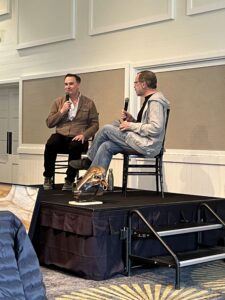
Some additional thoughts from the Powershift conference that took place in February in California – guests included artists, business leaders and even some legends (hello, Ed Catmull of Pixar fame)! This post touches on Peter Sims’ new book “BLK SHP: How to be Human in an Inhuman World” and what he and Ed are up to now.

When having it all is less than fulfilling
As he tells it, Peter Sims was getting paid a lot of money working in the financial sector in London, but increasingly feeling like a hamster on a treadmill. As he said in a podcast interview with author Whitney Johnson, “I don’t think I realized until maybe, maybe a half of the way through my experience with Summit in London when I realized, like, look, I’m just this is I’m supposed to be living the dream I’m in. I’m living in Holland Park. I’ve got a beautiful French girlfriend. I’m like, walking past Richard Branson and he’s reading the Financial Times and it’s like we’re neighbors. And yet I wasn’t fulfilled at a deeper level. And I think that happens to a lot of us.” What he was describing was what he calls the “white sheep” world of doing what’s expected, ticking the boxes and having success defined by conventional metrics.
He went to Stanford Business School, where he became familiar with former Medtronic CEO Bill George. This relationship eventually led to a best-selling book, True North which built on interviews and case studies with hundreds of leaders, based on the concept that leaders who know their values and lead authentically with those will be more effective. Another book, Little Bets: How Breakthrough Ideas Emerge from Small Discoveries emerged from insights gained at the Stanford “D” (Design) school, with the central premise that by pursuing many small experiments, innovators can achieve radically different results at low-risk (this was the book that first made me aware of Peter’s work).
Building movements
Along the way, he got involved with “Giving Tuesday,” in 2012, a project spearheaded by Henry Timms at the 92nd Street Y, to create a national day of charitable giving. As Peter would later describe it, Giving Tuesday was one of his first tastes of catalyzing a movement. It was also a recognition of his talent for making people feel involved and a part of something meaningful. As he describes it, “My job was to really try to catalyze a bunch of influencers and partners, including the White House, to get behind it. And that first year, people thought we were crazy… I was at the White House trying to persuade people that Henry was a legitimate person. He was just a mid-manager at the 92 Y at the time, and he’s since become the CEO of Lincoln Center. He’s gone on to all kinds of amazing things, but nobody really took it seriously, took us seriously.” That didn’t last long – thanks to the unique influences and the connections the group built, they raised $10 million their first year. As he recalls realizing, movement building is a lot like entrepreneurship – you have to appeal to one constituency at a time, building it steadily as you go.
Which brings us to the connection between Ed Catmull, one of the most influential innovators of the modern era, who, together with Steve Jobs and people like John Lassiter and George Lucas, would create the digital film industry, worth something like $400 billion today.
The concept for BLK SHP emerged from a connection Peter and Ed made about leveraging the talents of those who were willing to go beyond the conventional to find unique solutions and methodologies. A memorable turning point came at a dinner to which architect Frank Gehry (whom Peter had interviewed for Little Bets) attended – incidentally drawing his own journey as a Black Sheep on the dinner napkin (which Peter showed us at Powershift). As Peter recalls, “…there was just a lot of good energy at the table, filmmakers and entrepreneurs and what have you. And then he just started pounding the table and saying, well, you know, I think America needs an artistic renaissance. And when he said it, we just – we just sort of stopped and we were like, wow, that’s a really interesting, important idea.”
Peter’s skills at bringing together diverse talents and mobilizing them (perhaps honed through all those years of persuading entrepreneurs to let his parent company invest in their ventures) led him to think of whether the BLK SHP could be the foundation of a “new renaissance.”
Ed Catmull’s recollections of the history of Pixar
In an interview with Catmull at Powershift, Catmull outlined some of the twists and turns of Pixar’s origins, including how George Lucas’ 1983 divorce, led to his losing half his fortune, putting what was then the Computer Graphics Division of Lucasfilm potentially on the chopping block. In desperation not to lose the huge progress the division had made toward creating truly computer-animated films, several of the founders wanted to keep the work going by founding their own company. It would sell hardware, initially, what they called the Pixar Image Computer. VC’s weren’t interested. A near deal with General Motors fell apart when H. Ross Perot (founder of Electronic Data Systems which GM owned) voiced anger at another deal for a tech firm that he didn’t think was a good fit.
Out of desperation, they went to see Steve Jobs, recently ousted from Apple in an epically humiliating manner. After having earlier turned Jobs down when he wanted to buy their company, the founders persuaded him to invest, to which he agreed, taking 70 percent of the company while the employees owned the remaining 30 percent. As an observer said, the thing that kept them going was the idea of digital technologies as a new art form, with the ultimate goal of making “the movie.” It unfortunately took a lot longer than the founding team expected – as Peter remarked in interviewing Ed, “You thought it would take 10 years to make the first digital film for Lucasfilm, and it actually took 20 years.” The company failed over and over again, ran out of money and went back to Jobs, who eventually ended up sinking $50 million into the company, half the money he’d made from Apple. He eventually did end up owning the company outright.
Finally, technology advances finally made it possible to envision how “the movie” might become feasible, and over a four-year effort, Pixar developed “Toy Story” which premiered in 1995. It was so successful that Jobs was able to take Pixar public, salvaging his reputation and making him a billionaire. Disney eventually bought the company in 2006 for $7 billion, an astonishing amount for a company they could have had for a fraction of that some years earlier.
And now, a new chapter opens
BLK SHP over the years has done a lot of experimenting and reaching out to connect disparate talents to realize its vision. Its latest move is to create a venture investing arm so that the artists and others involved in the new American renaissance can have access to the resources that would allow them to be as transformative as Pixar has been in its day. As Peter puts it, “…that’s where we are now. We really have a chance to make a big impact and create wealth for our foundation and live that dream towards being a part of a creative renaissance. And that is an incredible place to be. But it took a decade of scrapping and struggles and trying to learn how to be an entrepreneur and trying to develop self-awareness and a lot of in-between before getting to this place.”
Will it work? With the serendipitous path that brought the founders to this place, I wouldn’t put it past them to make it work. And wouldn’t you like it to?
